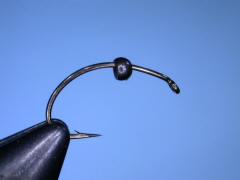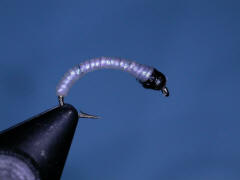|
Fly of
the Month
Bob Ireton brings together his
experience in fly fishing, aquatic entomology, and knowledge of fly
tying techniques and materials, to design and tie durable and
effective flies.
|

|

Volume 6, Issue5
May 2005

MIDGE LARVA
Fly, Text, and Photography by Bob Ireton
Midges are of general importance to freshwater ecosystems, often
being a major fish food and an important part of bottom-dwelling
communities. Game fishes feed on many kinds of Diptera that live in the
water.
The most common midge larval imitation is simply a segmented tube.
This can be accomplished in a number of different ways. By using hooks
of different size and shape, and varying the types and colors of the
materials used, practically any midge larva can be easily imitated.
MATERIALS
Hook – Daiichi 1130, Dai-Riki 135, Mustad 80250BR, Orvis 1639,
TMC 2487, or equivalent.
Size – 12-20.
Head – 5/64” Diameter Black Cyclops Eye bead.
Thread – 8/0 Black.
Body – LAGARTUN varnished poly-tinsel.
Overbody Coating – SOFTEX Clear Flexible Coating.
TYING STEPS - click on
pictures for larger view
|
1 – Insert the point of the hook through the smaller hole of the bead.
If you use the larger size hole, the bead will slip over the hook eye.
Now place the hook properly in the vice. If not using a hook with a
micro barb, mash it down. You will find that this pattern will need to
be tied on a larger size hook to look correct. For this fly, I am using
a Daiichi 1130, in size 12. |
 |
|
2 – To properly mount the bead, prepare a thread base behind the hook
eye. As you build it up, check the fit of the bead. When it is almost
snug, tie a whip finish, and remove the thread. |
 |
|
3 – Put a little head cement, or other type of glue, on the thread. Push
and twist the bead forward until it is snug against the hook eye.
Reattach the working thread behind the bead, and build a thread ramp
behind the bead to keep it snug, and in place. Bring the thread rearward
to form a solid base. Stop near the end of the curve of the shank, and
tie a half hitch. |
 |
|
4 – Tie in the body material at the rear of the thread base, and tie a
half hitch. Bring the thread forward, and tie a half hitch behind the
bead. |
 |
|
5 – Palmer the body material forward, keeping the wraps even, and snug.
A rotary vice works well here. When the material just reaches the bead,
tie it off. Tie a half hitch between the body material and the bead. |
 |
|
6 – Carefully snip off the excess body material. Make several wraps of
thread to secure the body material. Put a thin coat of head cement on
the thread adjacent to the bead, and apply several half hitches. Remove
the working thread. |
 |
|
7 – Coat the entire body with the Softex. If you are using a rotary
vice, rotate the fly as the Softex dries. This will insure an even
surface. |
 |
© 2005 Robert R. Ireton, II
www.buckeyeflyfishers.com
Site designed and maintained by
Panfalone@fuse.net
|







